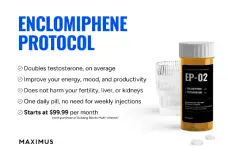madman
Super Moderator
Key Takeaways
- The TRAVERSE trial showed testosterone therapy's MACE risk is non-inferior to placebo, reassuring prescribers and patients.
- Despite the updated labeling, caution is advised due to potential venous thromboembolic events, particularly pulmonary embolism.
- Experts anticipate guideline updates to reflect the TRAVERSE findings, potentially expanding testosterone therapy access.
- The updated labeling may alleviate concerns, allowing more men to benefit from testosterone therapy.

Label change for testosterone: Implications for urologists, prescribers, and patients
In February 2025, the FDA recommended a removal of the black box warning related to an increased risk of adverse cardiovascular outcomes for all testosterone products. This recommendation has important implications for urologists and the patients they treat.
In February 2025, the FDA recommended a removal of the black box warning related to an increased risk of adverse cardiovascular outcomes for all testosterone products. This recommendation has important implications for urologists and the patients they treat.
In February 2025, the labeling requirements for testosterone caught up with what urologists and other prescribers have known for years: testosterone does not increase the risk of adverse cardiovascular outcomes.1
The journey to this conclusion began in 2014, when the FDA first convened a Joint Meeting of the Bone, Reproductive and Urologic Drugs and the Drug Safety and Risk Management Advisory Committee to discuss increased reports of stroke, heart attack, and death in men who were taking testosterone. The result of these discussions was to initiate a trial to assess the safety of testosterone in men with hypogonadism—a trial we now know as the TRAVERSE trial (NCT03518034).
The results from TRAVERSE were reassuring. Published in 2023 in the New England Journal of Medicine, the data showed that the incidence of major adverse cardiac events (MACE) for men on testosterone was non-inferior to that of those on placebo. Specifically, a MACE event occurred in 7.0% of patients taking testosterone vs 7.3% of patients taking placebo (HR, 0.96; 95% CI, 0.78 to 1.17; P < .001 for noninferiority).2
It's important to take into consideration the design of the TRAVERSE trial. TRAVERSE was a randomized controlled study that enrolled 5246 men aged 45 to 80 years who had a preexisting or a high risk of cardiovascular disease at study entry. Patients received either transdermal 1.62% testosterone gel (with the dose adjusted to maintain testosterone levels between 350 and 750 ng/dL) or placebo gel.
Although these results confirmed what many urologists already knew, the data may alleviate concerns for other prescribers of testosterone, such as those in primary care.
“There was a lot of fear and caution on a provider standpoint, even if you knew the data and knew that the risks were not significant or not dramatic,” said Landon Trost, MD, founder and director of the Male Fertility and Peyronie’s Clinic in Orem, Utah, in an interview with Urology Times® on the labeling changes.
More importantly, these findings may alleviate concerns for patients.
“Men have been deprived of testosterone therapy because of fears of MACE, and it now opens up testosterone therapy to very large groups of men who will benefit from it,” John P. Mulhall, MD, a urologic surgeon at Memorial Sloan Kettering Cancer Center in New York, New York, told Urology Times.
These findings push back against previous studies that raised concerns about the safety of testosterone. The original studies, though, had design flaws that called into question the accuracy of their findings.
According to Trost, “The original studies that reported these risks had numerous major flaws, and those involved in the testosterone side of things even called for retractions of some of these papers.”
This is important to discuss with patients when counseling them on the risks and benefits for testosterone, especially for those who may have concerns based on the original studies.
Helen L. Bernie, DO, MPH, an assistant professor of urology at Indiana University School of Medicine in Indianapolis, Indiana, explained her approach, saying, “When I'm talking to my patients, I explain the studies with them. I explain to them why we had that data. I talk to them about the newer studies and the safety. I specifically mention the TRAVERSE trial, because I think that helps give patients a lot of reassurance, because they recognize that it's a large, randomized controlled trial that showed safety in men who already were at high risk for cardiovascular disease.”
The Path Forward
However, testosterone should be used wisely in clinical practice, considering that TRAVERSE assessed MACE risk in a controlled environment, according to Steven E. Nissen, MD, a cardiologist at Cleveland Clinic in Cleveland, Ohio. Patients should be carefully counseled on the risks and benefits, and initiation of therapy should be done with a careful titration of dosage.He cautioned, “I want to say that while we agree with the FDA taking away the black box warning, this is not a license to give testosterone to every aging man who doesn't feel like they felt when they were 18 years old.”
Importantly, the FDA's labeling changes also recommended retaining the “Limitation of Use” language for age-related hypogonadism and required the addition of information on increased blood pressure for testosterone products.
There are also still unanswered questions following TRAVERSE. A comprehensive understanding of the true risks and benefits of testosterone are not fully elucidated. Specifically, there may be a need to specifically assess for the risk of venous thromboembolic events, according to Mulhall, who also chaired the guidelines committee for the AUA’s “Evaluation and Management of Testosterone Deficiency” guideline.
In the TRAVERSE trial, patients in the testosterone cohort experienced a higher incidence of pulmonary embolism, a component of venous thromboembolic events. Specifically, the incidence of pulmonary embolism was 0.9% in the testosterone cohort vs 0.5% in the placebo cohort. According to the authors, testosterone should be used cautiously in men with a previous history of venous thromboembolic events.
“I would say that the outstanding concern that I have would be the concept of venous thromboembolic events,” Mulhall said. “I think what we really need is a TRAVERSE study that is focused primarily on venous thromboembolic events in the testosterone therapy group.”
That being said, the labeling change for testosterone products reflects a key step forward in understanding the safety profile of this life-improving therapy. This change has significant implications for urologists and the patients that they treat.
“I'm excited about [the FDA] finally removing this box warning,” said Bernie. “I think it's something that many of us who prescribe testosterone therapy often have known for a long time, so it's nice to finally see this down in paper.”
The hope, according to experts, is that this suggested removal of the black box warning leads to other changes that reflect TRAVERSE findings.
“This is massively important,” said Mulhall. “It is my hope that the AUA will go back and change [the guideline] statement so that we now have guideline-based instructions to physicians that will say, ‘You are now allowed to say to patients that testosterone therapy is not associated with major adverse cardiovascular events.’”















